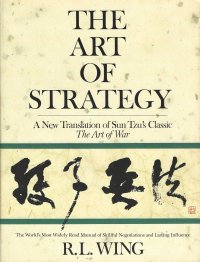 This is a “new” translation of Sun Tzu’s The Art of War, and as the slightly altered title indicates, it wants to extend the lessons of the master to situations other than war. The author/translator, as a matter of fact, breaks The Art of War into sections and then adds introductions before each section with how you can apply the lessons within each to Conflict with Yourself (internal struggles or battles with yourself when you want to improve), Conflict with the Environment (which is not Gaia, but rather circumstances in which you find yourself), Conflict with Another (where you disagree with another), and Conflict Among Leaders (when you have conflicts and you’re in authority).
This is a “new” translation of Sun Tzu’s The Art of War, and as the slightly altered title indicates, it wants to extend the lessons of the master to situations other than war. The author/translator, as a matter of fact, breaks The Art of War into sections and then adds introductions before each section with how you can apply the lessons within each to Conflict with Yourself (internal struggles or battles with yourself when you want to improve), Conflict with the Environment (which is not Gaia, but rather circumstances in which you find yourself), Conflict with Another (where you disagree with another), and Conflict Among Leaders (when you have conflicts and you’re in authority).
As you might remember, gentle reader, when dealing with classic texts, I tend to skip introductions until the end so that I can read the work first and then dig into the instructions. With this particular work, though, I gave up on reading the section introductions as it seemed the author was working too hard to draw out or make up lessons for each of the arbitrary sections. So most of this “report” is musings on the original work itself other than saying another, briefer translation might prove a better read and surely a better form-factor than this book, which in addition to the large introductions, includes the original Chinese on the left-facing pages along with a little calendar/notes spot so that you can study the sections over the course of time and to meditate on the teachings and how to apply them to your life as you study. So this is a coffeetable sized paperback, but you can find The Art of War in Barnes and Noble hardbacks or in mass market paperbacks that fit into your back pocket.
I read this book once or twice before when I was younger. So when I bought this book last Labor Day Weekend in Kansas, it was only a matter of time before I picked it up because I remember it as a short read. Well, it would have been, but the additional material kind of bogged me down even though I was not reading it. So I started it last summer or autumn and set it aside and then picked it up again recently.
At any rate, overall, The Art of War is pretty much a set of koans and things to meditate on which will kind of seem simple–don’t attack when your opponent is strong, appear to be in a different place than you are, and so on. So some good high-level things to consider, but if you’re actually wanting to study war and how to do it, you’re probably better off reading Julius Caesar, studying George Patton, or picking up a wargaming sourcebook. They provide practical details and considerations, like secure your corn and water first. Things no doubt taught to ancient Chinese military leaders, but not communicated very much in this text.
Reading this, though, one can appreciate how China might take a longer view of warfare and conflict that the West, but one has to wonder how that’s worked out. After all, much of China’s territorial gains have come from homelands of invaders who conquered China in kinetic warfare, become Chinese, and set up their own dynasty of “Chinese” emperors only to be overthrown by the next invading horde. I mean China never conquered Korea even though it’s right there (although who would want to, really) and didn’t hold onto its southeastern claims in Vietnam and whatnot.
I have probably mentioned before that I was approached to edit a book on how this was going to be China’s big century. But I demurred because I’ve read some Chinese history, and I know that a lot of centuries were going to be China’s century. I’m not as certain as this guy:
But I do think that the future will surprise us. Probably not in a good way, but it will certainly be different than what the modern clickbait prophets say it will be. Or what they said yesterday, which might be the complete opposite.



1 thought on “Book Report: The Art of Strategy by R.L. Wing (1988)”
Comments are closed.